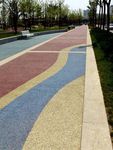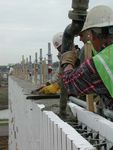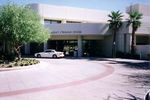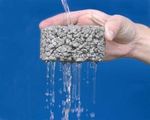Ready Mixed Concrete Industry LEED Reference Guide Update
←
→
Page content transcription
If your browser does not render page correctly, please read the page content below
Ready Mixed Concrete Industry LEED Reference Guide Update
February 2009
The United States Green Building Council (USGBC) will transition their
Leadership in Energy and Environmental Design (LEED) rating system
from LEED 2.2 to LEED 2009 as of March 1, 2009. Projects registered prior
to March 1 will have the option of meeting the requirements of LEED 2.2 or
LEED 2009 while projects registered after that date will fall under the 2009
version. The current version of the Ready Mixed Concrete Industry LEED
Reference Guide addresses the LEED 2.2 version. The RMC Research &
Education, partnering with the National Ready Mixed Concrete Association
(NRMCA), is working to update the Guide to incorporate the new changes
in version 2009 regarding the use and treatment of ready mixed concrete.
The revised Guide will be available this summer.
Until the revised Guide is available, we have included with the current
Guide an article written for Concrete inFocus by NRMCA’s Lionel Lemay,
senior vice president of sustainable Development and Erin Mack Ashley,
senior director of sustainable construction that details changes included in
LEED 2009. The article is included as an insert in the Guide hardcopy and
as an addendum at the end of the electronic version.
Should you have any questions, please contact the Foundation’s Jennifer
LeFevre at 240-485-1151 or at jlefevre@rmc-foundation.org. If you have
specific questions related to the LEED program, please contact Lionel
Lemay at 847-918-7101 or at llemay@nrmca.org or Erin Mack Ashley at
410-796-7975 or at eashley@nrmca.org.Concrete’s Contribution to LEED® 2009
By Erin Ashley, Ph.D., LEED AP, Senior Director, Sustainable Construction, NRMCA &
Lionel Lemay, P.E., LEED AP, Senior Vice President, Sustainable Development,
NRMCA
Using concrete in new buildings and major renovation projects can facilitate the process
of obtaining LEED® 2009 for New Construction (NC) and Major Renovations
certification. Leadership in Energy and Environmental Design (LEED) is a point rating
system devised by the United States Green Building Council (USGBC) to evaluate the
environmental performance of a building. The system is credit-based, allowing projects
to earn points for environmentally friendly strategies employed during the design and
construction process.
LEED was launched in an effort by the USGBC to develop a “consensus-based,
market-driven rating system to accelerate the development and implementation of green
building practices.” The program is not rigidly structured, i.e., not every project must
meet identical requirements to qualify. LEED for New Construction (NC) rating system
is currently in its third major iteration with LEED 2009 NC being introduced in March
2009. Both new buildings and major renovation projects can be certified using LEED
2009 NC. This paper details credits associated with the LEED 2009 NC where the use of
ready mixed concrete can contribute to achieving LEED points.
LEED 2009 NC rating system has five main credit categories: Sustainable Sites, Water
Efficiency, Energy & Atmosphere, Materials & Resources, and Indoor Environmental
Quality. Each credit category is divided into credits and outlines the intent, requirements,
technologies, and strategies for meeting each credit. Credits are broken down into
individual points. Additional points can be earned for Innovation & Design Process
credits and meeting specific Regional Priority Credits.
Credit Category Points Available
Sustainable Sites (SS) 26
Water Efficiency (WE) 10
Energy & Atmosphere (EA) 35
Materials & Resources (MR) 14
Indoor Environmental Quality (EQ) 15
Innovation & Design Process (ID) 6
Regional Priority Credits (RP) 4
Total Points Available 110
1Points for Certification
A building requires at least 40 points for basic certification level. Silver level requires 50
points, gold level requires 60 points, and platinum level requires 80 points. There are a
total of 110 points available.
LEED Certification Levels Points Required
Certified 40-49
Silver 50-59
Gold 60-79
Platinum 80+
Concrete and LEED
The following are suggestions for earning LEED points through the use of ready mixed
concrete products. The paragraph headings below correspond to the credit categories and
the credit numbers in the LEED 2009 NC rating system.
Development Density & Community Connectivity (Sustainable Sites Credit 2)
The intent of this credit is to channel development to urban areas with existing
infrastructure, protect greenfields and preserve habitat and natural resources. One strategy
to achieve this credit is to construct or renovate a building on a previously developed site
AND in a community with a minimum density of 60,000 square feet per acre. This
necessitates construction of multistory buildings. Concrete has long been the material of
choice for multi-story construction. Its strength, economy, and versatility make it ideal
for residential and commercial construction in urban settings. Features such as long
spans, low floor-to-floor heights, and energy efficiency also contribute to environmental
performance that can be used to gain LEED points in other credit categories. This credit
is worth 5 points.
2Concrete has long been the material of choice for multi-story
construction, a requirement for meeting Sustainable Sites Credit 2
in LEED 2009 NC.
Brownfield Redevelopment (Sustainable Sites Credit 3)
Cementitious materials can be used to solidify and stabilize contaminated soils and
reduce leaching concentrations to below regulatory levels. Although not typical, ready
mixed concrete trucks and plants have been used to mix and deliver cementitious slurries
for solidification and stabilization projects. To achieve this credit, documentation is
required indicating the site was contaminated or a site defined as a brownfield and the
remediation performed. This credit is worth 1 point.
Site Development: Protect or Restore Habitat (Sustainable Sites Credit 5.1)
The intent of this credit is to conserve existing natural areas and restore damaged areas to
provide habitat and promote biodiversity. Strategies include stacking the building
program and using tuck-under parking. Concrete parking garages within buildings can be
used to limit site disturbance. Parking garages located within a building helps maintain
3existing natural areas that would otherwise be consumed by surface parking. Using a
pervious concrete parking area to store and treat rainwater thereby eliminating or
minimizing land required for detention ponds help protect and restore habitat. This credit
is worth 1 point
Site Development: Maximize Open Space (Sustainable Sites Credit 5.2)
The intent of this credit is to provide a high ratio of open space to development footprint
to promote biodiversity by meeting specific ratios of open space to developed space.
Parking garages on the lower floors of a building can be used to help reduce the footprint
of a site development. Pervious concrete parking areas can eliminate or reduce land
required for detention ponds can help maximize open space. This is worth 1 point.
Stormwater Design: Quantity Control (Sustainable Sites Credit 6.1)
The intent of this credit is to limit disruption of natural water hydrology by reducing
impervious cover, increasing on-site infiltration, reducing or eliminating pollution from
stormwater runoff, and eliminating contaminants. Using pervious concrete pavements
will reduce the rate and quantity of stormwater runoff because they increase infiltration
of stormwater. Pervious concrete contains coarse aggregate, little or no fine aggregate,
and sufficient cementitious paste to bind the aggregate but provide a network of
interconnected voids between the coarse aggregates. The result is concrete with a high
volume of voids (15% to 25%) and high permeability that allows water to flow through
easily. Vegetated roofs (green roofs) are also identified as a strategy to achieve this
credit. Reinforced concrete is often used as the structural system to support the heavy
loads of vegetated roofs. This credit is worth 1 point.
Stormwater Design: Quality Control (Sustainable Sites Credit 6.2)
The intent of this credit is to limit the disruption of natural water flows by managing
stormwater runoff. To achieve this credit, a best management practice that removes 80%
or more of the total suspended solids in stormwater must be used. Pervious concrete
systems generally remove over 80% of total suspended solids and are considered a best
management practice for treating stormwater. Vegitated roofs (green roofs) can also be
used to meet the intent of this credit which are often supported by concrete structural
systems. This credit is worth 1 point.
4Pervious concrete pavements help control quantity and quality of
stormwater (Sustainable sites Credit 6.1 and 6.2) and help conserve
water resources (Water Efficiency Credit 1.1, 1.2, 2, and 3)
Heat Island Effect: Non-Roof (Sustainable Sites Credit 7.1).
The intent of this credit is to reduce heat islands (thermal gradient differences between
developed and undeveloped areas) to minimize impact on microclimate and human and
wildlife habitat. Strategies include providing shade for at least 50% of hardscaped
surfaces or provide hardscaped surfaces with solar reflectance index (SRI2) of at least 29.
The requirement for SRI can be met by using concrete rather than asphalt for 50% of all
sidewalks, parking lots, drives and other impervious surfaces.
Solar reflectance is the ratio of the amount of solar radiation reflected from a material to
the amount that shines on the material. Generally, light-colored surfaces have a high SRI.
Where paved surfaces are required, using materials with higher SRI will reduce the heat
island effect—consequently saving energy by reducing the demand for air conditioning—
and improve air quality.
Concrete generally has an SRI of greater than 29. Concretes made with white cements or
slag can have SRI greater than 78. As a comparison, new asphalt generally has an SRI of
5approximately 0, and asphalt five or more years old has an SRI of approximately 6. This
credit is typically achieved when parking areas, walks and plazas are paved with
concrete.
Another strategy to achieve this credit is to place a minimum of 50% of parking spaces
under cover including underground, under deck, under roof, or under building. Concrete
is typically the material of choice for parking structures. This credit is worth 1 point.
Concrete pavement can be used to reduce urban heat islands (Sustainable Sites
Credit 7.1)
Heat Island Effect: Roof (Sustainable Sites Credit 7.2)
The intent of this credit is to reduce heat islands (thermal gradient between developed and
undeveloped areas) to minimize impact on microclimate and human and wildlife habitat.
The requirement is to use highly reflective/high emissivity roofing for a minimum of
75% of the roof surface; or install a vegetated roof for at least 50% of the roof surface; or
a combination of both for 75% of the roof area. Concrete with high SRI can be used for
roofing and concrete structural systems are ideal for supporting the heavy loads of
vegetated roofs. This credit is worth 1 point.
Water Efficient Landscaping: Reduce by 50% (Water Efficiency Credit 1.1)
Water Efficient Landscaping: No Potable Water Use or No Irrigation (Water
Efficiency Credit 1.2)
The intent of these credits are to reduce or eliminate the use of potable water, or other
natural surface or subsurface water resources available on or near the project site, for
landscape irrigation. Strategies include using only captured rainwater, recycled
wastewater, recycled greywater for irrigation. Cisterns for capturing rainwater are often
built using concrete. Pervious concrete systems and other stormwater management
6systems can be used to capture stormwater for collection into cisterns for later use for
irrigation. Credit 1.1 is worth 2 points for 50% reduction from the mid-summer baseline
case and Credit 1.2 is worth an additional 2 Points for 100% reduction.
Innovative Wastewater Technologies (Water Efficiency Credit 2)
The intent of this credit is to reduce the generation of wastewater and potable water
demand, while increasing the local aquifer recharge. Strategies include the use of non-
potable water, recycled greywater, and on-site treated wastewater for sewage
conveyance. Concrete cisterns and treatment tanks can be used to fulfill the requirements
of this credit. This credit is worth 2 points.
Water Use Reuse Reduction (Water Efficiency Credit 3)
The intent of this credit is to further increase water efficiency within buildings to reduced
the burden on municipal water supply and wastewater systems. Employ strategies that in
aggregate use less water than a typical building. Strategies include using alternate on-site
sources of water, such as rainwater and stormwater. Pervious concrete systems in
combination with concrete cisterns can be used to fulfill the requirements for this credit.
This credit is worth 2, 3, or 4 points for 30%, 35%, and 40% reduction of water use from
the baseline.
Minimum Energy Performance (Energy & Atmosphere Prerequisite 2)
To achieve any level of LEED certification, buildings must demonstrate a 10%
improvement for new buildings or a 5% improvement for existing building renovations in
the proposed building performance rating compared to the baseline building performance
rating per ASHRAE/IESNA Standard 90.1-2007. The requirements of the ASHRAE
standard are cost-effective and support the use of thermal mass for building components.
Insulating to exceed the requirements of the standard is generally a wise business choice.
Building components constructed of concrete generally exhibit a property known as
thermal mass. This means the components have enough heat-storage capacity to moderate
daily temperature swings. Buildings constructed of cast-in-place frame, tilt-up, or
insulating concrete forms (ICF) along with precast concrete and concrete masonry
possess thermal mass which helps moderate indoor temperature extremes and reduces
peak heating and cooling loads. In many climates, these buildings have lower energy
consumption than non-massive buildings with walls of similar insulation; and heating,
ventilating, and air-conditioning needs can be met with smaller-capacity equipment. This
credit is prerequisite for certification and is not worth any points.
Optimize Energy Performance (Energy & Atmosphere Credit 1)
This credit is awarded if energy cost savings beyond a baseline can be demonstrated
compared to a baseline building that meets the requirements of ANSI/ASHRAE/IESNA
90.1-2007. Performance must be measured by a whole building project simulation using
the Building Performance Rating Method in Appendix G of the Standard. Many
engineering consulting firms have the capability to model a building to determine energy
savings as required using a computer-based program such as DOE2. When concrete is
considered, it is important to use a program like DOE2 that calculates yearly energy use
7on an hourly basis. Such programs are needed to capture the beneficial thermal mass
effects of concrete.
Insulated concrete systems, used in conjunction with other energy savings measures, will
most likely be eligible for points under this credit. The number of points awarded will
depend on the building, climate, fuel costs, and minimum requirements of the standard.
From 1 to 19 points are awarded for energy cost savings of 12% to 48% for new
buildings and 8% to 44% for existing buildings.
High performance concrete building systems such as insulating
concrete forms, tilt-up concrete and concrete frame construction
help a building meet the requirements of LEED 2009 NC energy
performance requirements.
Building Reuse (Materials & Resources Credit 1.1)
The purpose of this credit is to leave the existing building structure and shell in place
when renovating. The building shell includes the exterior skin and structural system but
excludes window assemblies, interior walls, floor coverings, and ceiling systems. This
8credit should be obtainable when renovating buildings with a concrete frame and/or skin
since concrete in buildings generally has a long life. This credit is worth 1 point if 55% of
the existing building structure and shell is left in place and 2 points if 75% is left in place
and 3 points for 95% is left in place.
Construction Waste Management: Divert 50% From Disposal (Materials &
Resources Credit 2.1)
Construction Waste Management: Divert 75% From Disposal (Materials &
Resources Credit 2.2)
These credits are provided for diverting construction, demolition, and land clearing
waste from landfill and incinerator disposal. It is awarded based on diverting at least 50%
by weight of the above listed materials. Since concrete is a relatively heavy construction
material and is frequently crushed and recycled into aggregate for road bases or
construction fill, this credit should be obtainable when concrete buildings are demolished.
In addition, returned concrete that is diverted from landfills by making landscaping
blocks or recycling into new concrete can be considered for this credit. MR Credit 2.1 is
worth 1 point if 50% of the construction, demolition, and land clearing waste are recycled
or salvaged and MR Credit 2.2 is worth 1 additional point if 75% is diverted.
Recycled Content: 10% (post-consumer + ½ pre-consumer) (Materials & Resources
Credit 4.1)
Recycled Content: 20% (post-consumer + ½ pre-consumer) Materials & Resources
Credit 4.2)
The intent of these credits are to increase demand for building products that incorporate
recycled content materials, thereby reducing impacts resulting from extraction and
processing of virgin materials. The requirements are to use materials with recycled
content such that the sum of post-consumer recycled content plus one-half of the pre-
consumer content constitutes at least 10% of the total value of the materials in the project
to receive 1 point (MR Credit 4.1) and 20% to receive 1 additional point (MR Credit 4.2).
Supplementary cementitious materials, such as fly ash, silica fume, and slag cement are
considered pre-consumer recycled content. Furthermore, using recycled concrete as
aggregate instead of virgin aggregates would qualify as post-consumer recycled content.
Although not considered part of concrete, most reinforcing bars are manufactured from
recycled steel and considered post-consumer recycled content.
This credit is worth 1 point for 10% recycled content (MR Credit 4.1) and 1 additional
point for 20% recycled content (MR Credit 4.2.).
Regional Materials, 10% Extracted, Processed & Manufactured Regionally
(Materials & Resources Credit 5.1)
Regional Materials, 20% Extracted, Processed & Manufactured Regionally
(Materials & Resources Credit 5.2)
The intent of these credits is to increase demand for building materials and products that
are extracted and manufactured within the region, thereby supporting the use of
indigenous resources and reducing the environmental impacts resulting from
transportation. The requirements of these credits are to use building materials or products
9that have been extracted, harvested or recovered, as well as manufactured, within 500
miles of the project site for a minimum of 10% (based on cost) of the total materials
value for 1 point and 20% for 2 points. If only a fraction of a product or material is
extracted, harvested or recovered and manufactured locally, then only that percentage (by
weight) shall contribute to the regional value. Ready mixed concrete will almost always
qualify since ready mixed concrete plants are generally within 500 miles of a job site and
most of the ingredient materials are harvested within 500 miles. The percentage of
materials is calculated on a cost basis.
This credit is worth 1 point if 10% of the building materials are regional (MR Credit 5.1)
and 1 additional point if 20% of the building materials are regional (MR Credit 5.2).
Daylight & Views: Daylight 75% of Spaces (Indoor Environmental Quality Credit
8.1)
Daylight & Views: Views for 90% of Spaces (Indoor Environmental Quality Credit
8.2)
The intent of these credits are to provide for the building occupants a connection between
indoor spaces and the outdoors through the introduction of daylight and views into the
regularly occupied areas of the building. The strategy is to design the building to
maximize interior daylighting and views to the outdoors through building orientation,
shallow floor plates, and increased building perimeter. Concrete floor systems can span
large distances with shallow floor plates and column free spaces to help achieve these
credits. You can also use exposed concrete ceilings to reflect light deep into interior
spaces. This credit is worth 1 point if 75% of the space has daylight (Credit 8.1) and 1
additional point if 90% of the space has views to the outdoors.
Concrete floor systems can span large distances with shallow floor systems
helping improve daylights and views (Indoor Environmental Quality Credit 8.1
and 8.2)
10Innovation in Design (Innovation & Design Process Credit 1)
These points can be applied for if an innovative green design strategy is used that does
not fit into the point structure of the five LEED categories or if it goes significantly
beyond a credit requirement in one of the existing credit categories. For example, if the
project team used materials on the project such that 30% of the materials were extracted,
processed & manufactured regionally then the project could receive an extra point in
going significantly beyond the requirements of Materials and Resources Credit 5.2.
Concrete contributes significantly to this credit category and therefore could be used to
achieve an Innovation in Design credit.
Another example would be if the design team used materials on the project such that they
have over 30% recycled content thereby exceeding Materials and Resources Credit 4.2 by
10 percentage points. Concrete made with some percentage of recycled aggregate in
combination with supplementary materials can contribute significantly to this credit.
One strategy that has been used to obtain a LEED point in the Innovation in Design credit
category is to reduce CO2 in concrete by 40%. One way to accomplish this is by using
high volumes of fly ash, slag, or silica fume in concrete such that the result is a decrease
in embodied CO2 by 40% over typical mixes in the area.
Another potential innovation is to use exposed concrete for walls, floors, and ceilings.
This strategy would eliminate a significant quantity of wall and floor coverings along
with ceiling materials, all of which are common sources of volatile organic compounds
(VOCs) that can degrade indoor air. This strategy could significantly improve indoor air
quality.
1-5 points are available under the Innovation & Design Credit.
LEED Accredited Professional (Innovation & Design Process Credit 2)
The intention of this credit is to encourage the design integration required by a LEED
2009 for New Construction green building project and to streamline the application and
certification process. To achieve this credit, at least one principal participant of the
project team shall be a LEED Accredited Professional (AP). Most LEED projects will
have a LEED AP as a member of the design team. In addition, the concrete industry has
many LEED Accredited Professionals available to help maximize points for concrete.
This credit is worth 1 point.
Regional Priority Credit (Regional Priority Credit 1)
These regional bonus credits are identified by USGBC Chapters and Regional Councils
for each “environmental zone” and a maximum of 4 points are available for project teams
to pursue in this credit category. Each USGBC Region will have the authority to create 6
potential bonus credits, of which one may pursue a maximum of four. This is a new
category of credits available under LEED 2009. This allows for the "regional authority"
to designate targeted credits that are of particular importance for a region, and potentially
give additional credits for projects that meet criteria in existing credit categories.
11For example, in a region where urban heat island reduction is identified as an important
goal, the USGBC Chapter could increase the points available for Sustainable Sites Credit
7.1 and 7.2 to 2 points each instead of 1 point thus creating greater incentive for design
teams to employ heat island reduction strategies of these credits. Since concrete
contributes to most credit categories it will play a significant role in achieving Regional
Priority Credits. 1-4 points are available for this credit.
Benefits of LEED Certification
LEED certification is a voluntary program. However, obtaining a LEED certification
demonstrates a positive environmental image to the community. Additionally,
implementing green building practices can result in energy and cost savings over the life
of the structure. Other advantages include better indoor air quality and plenty of daylight.
Studies have shown that workers in these environments have increased labor
productivity, job retention, and days worked. These benefits contribute directly to a
company’s profits because salaries—which are about ten times higher than rent, utilities,
and maintenance combined—are the largest expense for most companies occupying
building space. Students in these environments have higher test scores and lower
absenteeism.
Detailed information on the LEED program and project certification process is available
on the USGBC website, www.usgbc.org. More information about the environmental
benefits of concrete can be found at www.nrmca.org/greenconcrete.
12Sidebar:
Concrete’s Potential Contribution to LEED 2009 Certification
Credit Category Points for Concrete
Sustainable Sites (26 Points Available)
SS Credit 2: Development Density & Community Connectivity 5
SS Credit 3: Brownfield Redevelopment 1
SS Credit 5.1: Site Development: Protect or Restore Habitat 1
SS Credit 5.2: Site Development: Maximize Open Space 1
SS Credit 6.1: Stormwater Management: Quantity Control 1
SS Credit 6.2: Stormwater Management: Quality Control 1
SS Credit 7.1: Heat Island Effect: Non-Roof 1
SS Credit 7.2: Heat Island Effect: Roof 1
Water Efficiency (10 Points Available)
WE Credit 1.1: Water Efficient Landscaping: Reduce by 50% 2
WE Credit 1.2: Water Efficient Landscaping: No Potable Water Use or No Irrigation 2 additional
WE Credit 2: Innovative Wastewater Technologies 2
WE Credit 3: Water Use Reduction
30% Reduction 2
35% Reduction 1 additional
40% Reduction 1 additional
Energy & Atmosphere (35 Points Available)
EA Prerequisite 2: Minimum Energy Performance required
EA Credit 1: Optimize Energy Performance:
12-48% New Buildings or 8 -44% Existing Buildings 1-19
Materials & Resources (14 Points Available)
MR Credit 1.1 Building Reuse: Maintain Existing Walls, Floors & Roof
55% Building Reuse 1
75% Building Reuse 1 additional
95% Building Reuse 1 additional
MR Credit 2.1 Construction Waste Management, Divert 50% From Disposal 1
MR Credit 2.2 Construction Waste Management, Divert 75% From Disposal 1 additional
MR Credit 4.1 Recycled Content, 10% (post-consumer + ½ pre-consumer) 1
MR Credit 4.2 Recycled Content, 20% (post-consumer + ½ pre-consumer) 1 additional
MR Credit 5.1 Regional Materials, 10% Extracted, Processed & Manufactured Regionally 1
MR Credit 5.2 Regional Materials, 20% Extracted, Processed & Manufactured Regionally 1 additional
Indoor Environmental Quality (15 Points Available)
EQ Credit 8.1: Daylight & Views: Daylight 75% of Spaces 1
EQ Credit 8.2: Daylight & Views: Views for 90% of Spaces 1
Innovation and Design Process (6 Points Available)
ID Credit 1: Innovation in Design 1-5
ID Credit 2: LEED Accredited Professional 1
Regional Priority (4 Points Available)
RP Credit 1: Regional Priority Credit 1-4
Total 37-62
LEED 2009 Scoring System
Certified 40-49 points
Silver 50-59 points
Gold 60-79 points
Platinum 80+ points
13You can also read























































